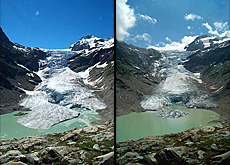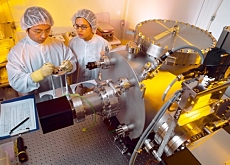Swiss find frozen Siberia is heating up

Temperatures in Central Asia's mountain region have risen a lot more than was thought, according to new research by Swiss and Russian scientists.
Ice-core samples analysed at the Swiss-based Paul Scherrer Institute (PSI) show that the temperature of the Belukha glacier has increased by 2.5 degrees Celsius in the past 150 years.
That is three times the northern hemisphere average of 0.9 degrees – an unforeseen result, according to expedition leader Margit Schwikowski, head of the PSI’s analytical chemistry group.
“It’s generally known that most of the glaciers are retreating so this is not a surprise. But to have such a high degree of warming [in this Siberian glacier] was quite surprising,” Schwikowski told swissinfo.
The glacier is located in the Altai region, where Russia, China, Kazakhstan and Mongolia meet. According to Schwikowski, the surrounding landscape was virtually untouched until the 1940s.
“Policy during the Stalin era shifted [sections of the] population to Siberia and started industrial complexes there. From then on, the pollution started,” she explained.
The PSI said the Belukha glacier, which lies at over 4,000 metres, is an” excellent climate and environment archive”.
The region has a continental climate, which is thought to be particularly susceptible to warming due to greenhouse gases – a suspicion confirmed by analysis of the ice-core.
Field trip
During the expedition to collect samples, which took place in 2001, the team expected to find the region relatively untouched by serious pollution, given that the industrial zones had been located at least 500 kilometres away.
However, their research – the initial goal of which was to look into mercury contamination within the area – revealed a number of surprises.
“We were surprised that the level of pollution in the Altai was comparable to what we have in the European Alps, which are surrounded by industrialised countries,” she said
Also, she added, industrialisation in European countries took place in the 19th century, much earlier than in the former Soviet Union.
Researchers found that the level of pollutants tailed off in the 1980s, a decade before the collapse of the bloc, implying that the country’s maximum industrial output had reached its peak before then.
Consequences
Schwikowski warned that the water supply would suffer if the warming rate continued at its present rate or accelerated.
“Nowadays, glaciers form a kind of water reservoir; the water is released by their melting and the snow cover of the glacier is released continuously – this is the water supply,” she said.
Once the glaciers melted away completely, a buffer would be lost, resulting in extreme weather events such as flooding or heavy rain.
“You will not have a constant supply of water anymore when the glaciers are no longer there, so there might be one rainfall with a lot of water, followed by a long dry period,” she said.
Schwikowski stressed that Switzerland could also face a similar fate.
“This will also be the situation here in the Alps, when the glaciers have disappeared. We will need more dams for guaranteeing a constant water supply,” she underlined.
Research released by Nasa last week revealed that Greenland’s glaciers were shrinking far more quickly than had been assumed. Temperatures around the southern tip of Greenland have risen by 5.4 degrees in the past 20 years, causing glaciers literally to slide into the sea.
swissinfo, Faryal Mirza
The Paul Scherrer Institute (PSI) is a publicly funded research organisation, located in northern Switzerland.
Because it focuses on basic research, the PSI pioneers its own experimental methods, which are often later adopted elsewhere.
Areas of research include, among others, nanotechnology, biotechnology and nuclear energy.
The glacier is located in the Altai region, where Russia, China, Kazakhstan and Mongolia meet.
The region has a continental climate, which is thought to be susceptible to warming from greenhouse gases.
The area is heavily polluted, despite being located 500 kilometres from Soviet-era industrial zones.

In compliance with the JTI standards
More: SWI swissinfo.ch certified by the Journalism Trust Initiative



You can find an overview of ongoing debates with our journalists here . Please join us!
If you want to start a conversation about a topic raised in this article or want to report factual errors, email us at english@swissinfo.ch.